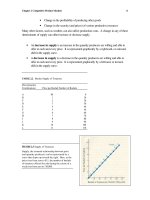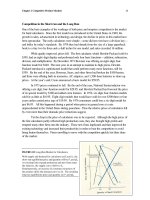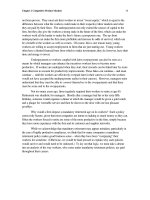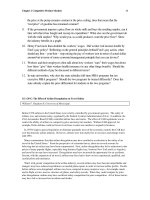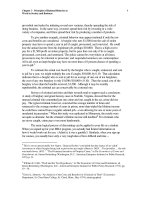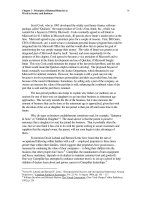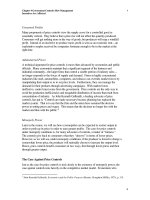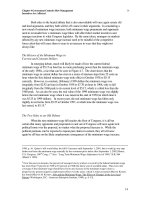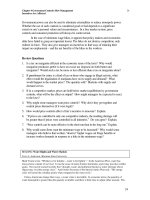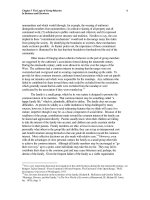Tài liệu Microeconomics for MBAs 8 pdf
Bạn đang xem bản rút gọn của tài liệu. Xem và tải ngay bản đầy đủ của tài liệu tại đây (115.98 KB, 10 trang )
Chapter 2 Competitive Product Markets
30
not been proven. They must ask their workers to invest “sweat equity,” which is equal to the
difference between what the workers could make in their respective labor markets and what
they are paid by their firms. The underpayments not only extend the sources of capital to the
firm, but they also give the workers a strong stake in the future of the firm, which can make the
workers work all the harder to make the firm’s future a prosperous one. The up-front
underpayments can make the firm more profitable and increase its odds of survival, which can
be a benefit to the workers as well as owners. Of course, this is one reason many young
workers are willing to accept employment in firms that are just starting out. Young workers
often have a limited financial base from which to make investments; they do, however, have their
time and energy to invest.
Underpayments to workers coupled with later overpayments can also be seen as a
means by which managers can enhance the incentives workers have to become more
productive. If workers are underpaid when they start, their rewards can be hiked later by more
than otherwise to account for productivity improvements. These hikes can continue – and must
continue -- until the workers are effectively overpaid later in their careers (or else the workers
would not have accepted the underpayments earlier in their careers). However, managers must
understand that they must be able to commit themselves to the overpayments and that there
must be some end to the overpayments.
Not too many years ago, firms regularly required their workers to retire at age 65.
Retirement was ritualistic for managers. Shortly after a manager had his or her sixty-fifth
birthday, someone would organize a dinner at which the manager would be given a gold watch
and a plaque for venerable service and then be shown to the door with one last pleasant
goodbye.
Why would a firm impose a mandatory retirement age on its workers? Such a policy
seems truly bizarre, given that most companies are intent on making as much money as they can.
Often the workers forced to retire are some of the more productive in the firm, simply because
they have more experience with the firm and its customer and supplier networks.
While we acknowledge that mandatory retirement may appear mistaken, particularly in
the case of highly productive employees, we think that for many companies a mandatory
retirement policy makes good business sense – when they have been “overpaying” their
workers for sometime. (Otherwise, we would be hard pressed to explain why such policies
would survive and would need to be outlawed.) To lay out that logic, we must take a detour
into an analysis of the way workers, who come under mandatory retirement policies, are paid
throughout their careers.
Chapter 2 Competitive Product Markets
31
Paying market wages, or exactly what workers are worth at every stage in the worker’s
career, does not always maximize worker incomes. That was a central point of the discussion
to this point. We extend that discussion here by showing how the manipulation of a worker’s
career wage structure, or earnings path over time, can actually raise worker productivity and
lifetime income. However, as will also be shown, when worker wages diverge from their value
over the course of their careers, mandatory retirement is a necessary component of the labor
contract.
11
Suppose that a worker goes to work for Apex, Inc. and is paid exactly what she is
worth at every point in time. Assume she can expect to have a modest productivity
improvement over the course of a thirty-year career, described by the slightly upward sloping
line A in Figure 2.13. If her income follows her productivity, her salaries will rise in line with the
slope of line A. In year Y
1
, the worker’s annual income will be I1; in year Y
2
, it will be I
2
, and
so forth.
Is there a way by which management can restructure the worker’s income path and, at
the same, enable both the workers and the firm to gain? No matter what else is done,
management must clearly pay the worker an amount equal at least to what he or she is worth
over the course of her career. Otherwise, the worker would not stay with the company. The
worker would exit the firm, moving to secure the available higher career income. However,
management need not pay each year an amount equal to the income points represented on line
A. Management could pay the worker less than she is worth for awhile so long as management
is willing to compensate by overpaying her later.
For example, suppose that management charts a career pay path given by line B, which
implies that up until year Y
3
, the workers are paid less than they are worth, with the extent of the
underpayment equaling the shaded area between the origin and Y3. However, the workers
would be compensated for what amounts to an investment in the firm by an overpayment after
year Y
3
, with the extent of the overpayment equal to the shaded area above line A after Y
3
.
FIGURE 2.13 Twisted Pay Scale
The worker expects his productivity to rise
alone line A with years of service. If she starts
work with less pay that she could earn
elsewhere, then her career pay path could
follow line B, representing greater increases in
pay with time and greater productivity.
11
For the analysis presented here, we are indebted to the work of University of Chicago economist Edward
Lazear [Edward Lazear, “Why Is There Mandatory Retirement?” Journal of Political Economy, vol. 87
(December 1979), pp. 1261-1284].
Chapter 2 Competitive Product Markets
32
Are the firm and worker likely to be better off? Notice that the actual proposed pay
line B is much steeper than line A, which, again, represents the worker’s income path in the
absence of management’s intentional twisting of the pay structure. The greatest angle of line B
means that the worker’s income rises by more than warranted by the year-to-year increases in
her productivity. This implies that the worker has a greater incentive to actually do what
management wants done, which is increase productivity. This is the case because the worker
gets a disproportionately greater reward for any given productivity improvement. The increase
in productivity can translate into greater firm revenue, which can be shared between the
workers, management, and owners.
Would workers ever want to work for a firm that intentionally underpays its workers
when they are young or just starting out with the company? You bet. The workers can reason
that everyone in the firm will have a greater incentive to work harder and smarter. Hence, they
can all enjoy higher prospective incomes over the course of their careers. Normally,
commentaries on worker pay implicitly assume that the pay structure is what management
imposes on workers. Seen from the perspective of the economic realities of what is available
for distribution to all workers in a firm, we could just as easily reason that the kind of pay
structure represented by line B is what the workers would encourage management to adopt.
Actually, the twisting of the pay structure is nothing more than an innovative way for managers
to increase the money they make off their workers while also increasing the money workers are
able to make off their firms. In short, it is a mutually beneficial deal, something of a “free good,”
in the sense that more is available for everyone.
If twisting the pay structure is such a good idea, why isn’t it observed more often than it
is in industry? Perhaps some variant of twisted pay schedules is more widely used than thought,
primarily because they are not identified as such. Public and private universities are notorious
for making their assistant professors work harder than full professors who have tenure and far
more pay. Large private firms, like General Motors and IBM, appear to have pay structures
that are more like line B than line A. However, millions of firms appear to be unwilling or unable
to move away from a pay structure like line A.
One of the problems with line B is that young workers must accept a cut in pay for a
promise of greater pay in the future -- and the pay later on must exceed what the workers can
get elsewhere and, what is crucial to workers, more than what their firm would have to pay if
they simply hired replacement workers at the going market wage. Obviously, the workers take
Chapter 2 Competitive Product Markets
33
a considerable risk that their firm will not live up to its promise by deciding not to raise their pay
later to points above their market wage or, what is worse, fire them.
Needless to say, the firm must be able to make a credible commitment to its workers
that it will live up to its part of the bargain, the quo in the quid pro quo. Truly credible
commitments require that the firm be able to demonstrate a capacity and inclination to do what
it says it will do. The firm must be believable by those who make the early wage concessions.
Many firms are not going to be able to twist their pay structures, and gain the productivity
improvements, because they are new, maybe small, with a shaky financial base and an uncertain
future. New firms have little history for workers to assess the value of their firms’ commitments.
Small firms are often short-lived firms. Financially shaky firms, especially those which suffer
from problems of insolvency or illiquidity, will unlikely be able to garner the trust of their
workers. Firms that are in highly fluid, ever-changing and competitive markets, will also be
unlikely candidates for being able to twist their pay structures. They all will tend to have to pay
workers their market worth, or even a premium to accommodate the risks the workers must
accept when the company’s existence is in doubt.
What firms are most likely to twist their pay structures? Ones that have been
established for some time, have a degree of financial and market stability, have some monopoly
power -- and have proven by their actions that their word is their bond. To prove the latter,
firms cannot simply go willy-nilly about dismissing workers or cutting their pay when they find
cheaper replacements. To do so would be an undermining of their credibility with their
workers.
We can’t be too precise in identifying the types of firms that can twist their pay
structures for the simple reason that there can be extenuating circumstances. For example, we
can imagine some unproved up-start companies would be able to pay their workers below
market wages. Indeed, they may have to do so simply because they do not have the requisite
cash flow early in their development. New firms often ask, or demand, that their workers
provide “sweat equity” in their firms through the acceptance of below-market wages, but always
with the expectation that their investment will pay off. Which new firms are likely to be able to
do this? We suspect that firms with new products that represent a substantial improvement over
established products would be good candidates. The likely success of the new product gives a
form of base-line credibility to firm owner commitments that they intend -- and can -- repay the
“sweat equity” later. Indeed, the greater the improvement the new product represents, the more
likely the firm can make the repayment, and do so in an expeditious manner, and the more likely
the workers will accept below-market wages to start. The very fact that the product is a
substantial improvement increases the likelihood of the firm’s eventual success for two reasons.
The first reason is widely recognized: a product that represents a substantial improvement will
likely attract considerable consumer attention. The second reason is less obvious: the firm can
delay its wage payments, using its scarce cash flow in its initial stages of production for other
things, such as quality control, distribution, and promotion. The firm gets capital -- sweat equity
-- from an unheralded source, workers. The workers’ investment of their sweat equity can
enhance the firms’ survival chances and, thereby, even lower the interest rate that the firms must
pay on their debt (because the debt is more secure).
Chapter 2 Competitive Product Markets
34
Of course, there are times when firms must break with their past commitments. For
example, if a firm, which was once insulated from foreign competition, must all of a sudden
confront more cost-effective foreign competitors in domestic markets (because, say,
transportation costs have been lowered), then the firm may have to break with its commitments
to overpay workers late in their careers. If they don’t, the competition will simply pay people
the going market wage and erode the markets of those firms who continue to overpay their
older workers. Without question, many older American workers, for example, middle
managers in the automobile industry, have hard feelings about the advent of the “global
marketplace.” They may have suffered through years of hard work at below-market wages in
the belief that they would be able, later in their careers, to slack off and still see their wages rise
further and further above market. The advent of global competition, however, has undercut the
capacity of many American firms to fulfill their part of an implied bargain with their workers.
Even though they may have hard feelings, it does not follow that the workers would
want their firms to try to hold to their prior agreements. Many workers understand that their
wages can be higher than they otherwise would be if their firms kept their prior agreement.
Without the reneging, the firm might fold. In a sense, the workers made an investment in the
firm through their lower wages, and the investment didn’t pay off as much as expected.
However, we hasten to add that some American workers have probably been burned by firms
that have used changing market conditions as an excuse to
break with their commitments or that have sold their firms to buyers who felt no compulsion to
hold to the original owners’ prior commitments.
12
The answer to the question central to this section, “Why does mandatory retirement
exist?” can now be provided, at least partially. Mandatory retirement at, say, 65 or 70 may be
instituted for any number of plausible reasons. It might be introduced simply to move out
workers who have become mentally or physically impaired. Perhaps, in some ideal world, the
policy should not, for this reason, be applied to everyone. After all, many older workers are in
the midst of their more productive years, because of their accumulated experience and wisdom,
when they are in their sixties and seventies. However, it may still be a reasonable rule because
its application to all workers may mean that on average, by applying the policy without
exception, the firm is more efficient and profitable.
However, the expected fitness of workers at the time of retirement is simply not the
only likely issue at stake. We see mandatory retirement as we see all employment rules, as a
part of what is presumed to be a mutually beneficial employment contract, replete with many
other rules. It is a contract provision that helps both firms that adopt it and their workers who
12
The analysis can really get sticky, and convoluted, when it is recognized that commitments that firms make
are only implicitly made, with no formal contract, often with a host of unstated contingencies. For example,
many firms may commit to overpaying their workers if the firm is not sold and if market conditions do not
turn against them. Workers will simply have to consider those contingencies in the wages that they demand
early in their careers and later on. All we can say is, the greater the variety and number of contingencies, the
less the underpayment workers will accept early in their careers, and the less benefits firms and their workers
will achieve from twisting the wage structure.
